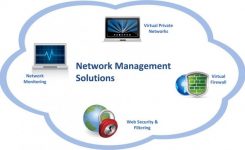Cloud Compute, Network Services, UCaaS
2019 Tech Trends
This article was originally published by ATI partner Comcast on Comcast Business Community.
The rate at which technology is evolving is increasing almost exponentially. In the business sector, hardware has given way to software-defined everything, while many on-premises technologies are now offered as a service. Much of the advances in technology over the last few years have been the direct result of the growing ubiquity of the cloud and faster connectivity speeds, both of which have enabled companies to adopt digital transformation technologies to help them work smarter and more efficiently.
In 2019, these forces will continue to impact enterprises across industries, as more organizations make the cloud and web-based applications an important part of their technology toolkits. Digital transformation efforts many companies began over the last few years will be the base for a new wave of solutions and services designed to grow their businesses even further and faster to outpace increasing competition.
As such, speed and intelligence will be the hallmarks of technologies demonstrating the highest value in 2019. From SD-WAN to edge computing and high-speed broadband to intelligent apps, technologies that enable networks to work at optimal levels will be in high demand, as companies strive to stay ahead of competition. In addition, technologies that promote collaboration across locations, such as unified communication services, will remain important to organizations of all sizes, regardless of industry sector.
SD-WAN: Finding Its Place as an Enabler
Software-defined wide area networking (SD-WAN) is experiencing a popularity surge, as a growing number of networking vendors look to add SD-WAN technologies to their lineups. IDC predicts the SD-WAN market globally will reach $4.5 billion by 2022, an impressive 40.4 percent compound annual growth rate from 2017.1
The benefits of SD-WAN are many, including cost savings, performance and availability enhancements and simplified administration and management. SD-WAN enables a level of agility traditional WANs are not capable of, and can manage the high volume data used by video and other types of multimedia—which is becoming more important in many companies’ marketing and social strategies—as well as other transactional data used by enterprise organizations.
Although SD-WAN has been around for a few years, its importance in digital transformation efforts haven’t been fully recognized until more recently. As more companies adopt cloud-based technologies and understand the importance of the network in advancing their business, SD-WAN is increasingly being hailed as an enabling technology.
That said, its original intent—as a replacement to costly MPLS connections—has since morphed into SD-WAN as a complementary technology: A number of organizations are using SD-WAN in addition to their MPLS networks, choosing to run their high-performance, mission-critical operations over MPLS and using SD-WAN for lower priority, internet-based traffic, such as their cloud-based as-a-service offerings—Office 365 or Adobe Cloud.2
Edge Computing: Democratizing Compute from the Data Center
SD-WAN is also enabling the concept of edge computing, which distributes computation away from the data center to devices at the edge of a network known as smart devices or edge devices. This distributed computing environment enables companies to analyze data in near real-time, better positioning them to make better decisions faster. Industries that depend on data to help decision-making, such as finance and health care, are adopting edge computing as a way to increase the accuracy of decisions and/or stay ahead of competition.
The growing use of Internet of Things (IoT) devices is one of the many factors spurring greater interest in edge computing. Research firm Stratistics MRC expects the global edge computing market will reach $20.5 billion by 2026, from $8 billion 2017.3 Other technologies including intelligent applications and intelligent wearable devices also are promoting edge computing as a must-have technology as companies extend their digital transformation strategies.
By taking some of the data processing away from the data center, edge computing offers the benefit of reduced latency, as data doesn’t have to traverse the network to be processed. That means not only faster insights, but also less data moving across the network at any given time.
Broadband Networks: Table Stakes in the Connectivity Game
The proliferation of broadband networks is rising, as companies recognize the benefits of high-speed connectivity as a catalyst for digital transformation. Gig-speeds in particular are alluring, offering the ability for super-fast uploads and downloads for streaming videos and other bandwidth-intensive applications, collaboration among employees in different locations and a more secure network through static IP addresses.
According to industry association USTelecom, Internet Protocol (IP) traffic in the United States is estimated at 48,272 petabytes per month in 2018 and is expected to rise to 79,640 petabytes by 2021.4 Traditional data pipes aren’t robust enough to handle such high traffic loads; for companies that rely on data to make intelligent, informed business decisions, broadband is becoming a must in ensuring data flows quickly, without lag or degradation.
Intelligent Apps: Making Real-Time Decision-Making Truly Real-Time
The need for data to be able to respond to market conditions in real time—whether it’s reacting to stock market activity by financial services organizations or switching to different machines on the production floor in anticipation of unplanned downtime in manufacturing—is driving a new breed of “intelligent apps” that utilize cloud computing and machine learning to respond and react accordingly.
The use of intelligent applications is still nascent, although the technology has the potential to be useful in a number of industries. In financial services, beyond reacting to stock market activity, intelligent apps could be used to predict or detect fraud. In a healthcare setting, providers could use intelligent apps to detect and track possible outbreaks of illness or disease—and get ahead of an outbreak before it becomes a full-blown epidemic. In retail, intelligent apps could be used to better predict inventory based on real-time shopping trends and external factors such as weather forecasts or logistics issues such as driver strikes, for example.
Unified Communications: Keeping Productivity High Through Collaboration
Unified communications, like SD-WAN, are not new technologies. But advances in networking, cloud and UC solutions themselves are renewing enthusiasm among organizations looking to ensure employees can communicate and collaborate effectively anytime and from anywhere. Mobile collaboration apps, for example, are bringing streamlined access to users, providing connectivity no matter what device they’re using—desktop, smartphone or tablet—and offering many of the same services across all platforms, such as videoconferencing, document sharing, chat and email, to name a few.
In addition, the cloud has had a major impact on unified communications, separating UC from proprietary PBX systems to make it easier for employees to utilize the benefits of unified communications without being tethered to their desks. And the high-speeds of broadband networks ensure communication is seamless without dropped calls or call degradation that can negatively impact the user experience.
Companies continue to see the value of unified communications as a driver for productivity: According to research firm Gartner, the unified communications-as-a-service market in North America in 2017 totaled almost $1.5 billion and is expected to reach about $2.8 billion by 2021.5
Taking Advantage of Tech Trends in 2019
The technology landscape in 2019 is rife with solutions designed to help organizations work faster and smarter than ever before. However, new-generation technologies can’t be sustained on legacy networks and IT architecture. To reap the benefits of these technologies, companies need sufficient bandwidth as well as smart, software-defined architecture to enable more capacity, flexibility and control of business applications running across an enterprise—from headquarters to the edges at the branch level—to enable better operations, improved and new customer and employee experiences.
As organizations strive to become ever more digitally focused, they need an environment that supports digital transformation from every point on the network. Hybrid cloud and network environments, SD-WAN and high-speed broadband are just some of the technologies that can enable companies to better manage their business applications across all locations, while networking components such as WiFi and unified communications ensure employees can work anytime, anywhere, with no impact on productivity.
What’s more, managed services can help organizations as they adopt new technologies without overly stressing their current network and to help streamline processes for IT managers, by tying disparate systems together and “filling in the gaps” as companies update current infrastructure and after networks have been upgraded.
Working with a network service provider can help IT leaders in their quest to adopt digital transformation technologies and embrace new services. By working with a network services provider, organizations can leverage virtual and physical private Ethernet connectivity to assure there are no issues regarding network performance and availability for critical applications at all company locations. They also can receive all or some of their most critical connectivity functions as a managed service, including managed connectivity, WiFi, security, voice and business continuity, among others.
Conclusion
Many of the forces that spurred the first wave of digital transformation are still very much in play in 2019; as such, speed and intelligence will be the hallmarks of technologies demonstrating the highest value in the next year. The digital transformation efforts many companies began over the last few years will be the base for a new wave of solutions and services designed to grow their businesses even further and faster to outpace their increasingly agile competitors.








